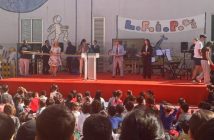
Among my kids’ favorite things about our corner of Beijing is Changping Park. It is modest, but it has its attractions: we can walk to it, for one. It also has some Chinese park essentials: rickety carnival rides and a small pond for pedal-boats, with a bonus not often seen in other gongyuan, the section called, “The Stone Inscription Garden.”
The Stone Inscription Garden is a random collection of damaged, abandoned statues and carvings, Ozymandian discoveries from around Changping. Installed in the park in the 2000s, there are stelae, tomb-guarding figures, and other rock sculptures that individually wouldn’t look out-of-place at any Beijing cultural property. Here in our park they appeared like an island of misfit relics.
I had trouble believing them to be real historic artifacts when I first saw them, thinking they were more recently produced imitations. Besides, the park was built around fake rocks, a fake lake, and even a fake zhonglou. I couldn’t imagine that The Stone Inscription Garden among all these other manufactured decorations was real.
The father of one of Myles’ friends showed me that the pieces were, in fact, authentic, dating from the Republican period back to maybe the late Ming Dynasty, all damaged by a number of 20th century events.
There were college students reclining on carved horses, some older women hanging their shopping bags on a stone ram before exercising together, and children playing hide-and-seek around fragments of stelae. I pondered the absence of reverence usually due ancient things, and watching Myles scramble around headless mandarins, wondered if it ought to be forbidden.
No, my friend assured me while his son scaled a cracked turtle. “These are old, but not precious.”
Only in a place like Beijing, I thought, could there be such a glut of centuries-old stone carvings that these ones couldn’t have much value.
The “old, but not precious” stones became our preferred playscape. Friends visiting from other parts of Beijing enjoyed our stone garden, so much better than famous sites where climbing was not allowed. My children, like all the local children, had many adventures mounted on the backs of the horses and rams. Brigid grew particularly attached to one stone horse she named Flower.
One afternoon late last summer, Myles, Brigid and I went to the park. Brigid made a beeline for Flower. Once we arrived at the Stone Inscription Garden, though, we found a high iron fence enclosing it. There were signs, too, promoting new cultural preservation initiatives in Changping District, including Great Wall towers, Silver Mountain Pagoda Forest, and the Stone Inscription Garden. It was a surprise to see our stone animals grouped with these antiquities, since only a few weeks before they were still more like a playground.
I tried to alleviate Brigid’s disappointment by explaining the fence would keep Flower safe for years to come. She did brighten when I read that the gate would be open every Saturday morning for two hours.
On a Saturday this spring, I took Brigid down to the Stone Inscription Garden right after breakfast. A few people walked quietly among the stelae and statues, and a volunteer attendant kept visitors from doing what we all used to do. Brigid reached to pet the stone horse (which was apparently allowed), then got out her notebooks to sketch Flower. She was respectful of Flower’s new status, though the horse had been precious to her all along.

About the Illustrator
Maggie, 9 years old, is an Art Lab Junior student at Blue Bridge International Education. Currently, she is in Grade 3 at Jingshan School and can always be found with a smile on her face. She loves art, especially free drawing. Additionally, she is a great swimmer. In the future, she hopes to become an artist.
About the Writer
Jennifer Ambrose hails from Western Pennsylvania and misses it terribly. She still maintains an intense devotion to the Pittsburgh Steelers. She has lived in China since 2006 and is currently an at-home mother. With her husband Randy and children Myles and Brigid, she resides outside Sixth Ring Road in Changping. Her blog can be found at jenambrose.blogspot.com.
This article originally appeared on page 53 of the beijingkids August 2015 issue. Click here to read the issue for free on Issuu.com. To find out how you can get your own copy, email distribution@truerun.com.


